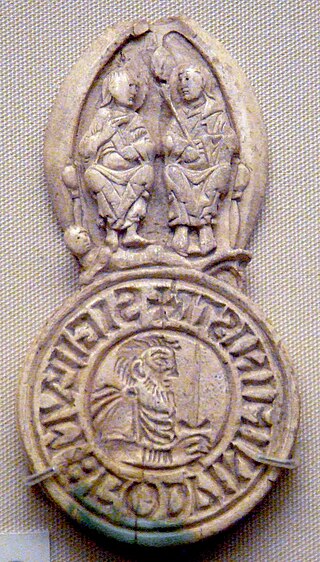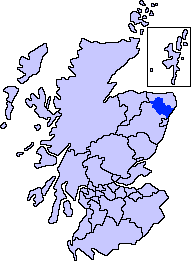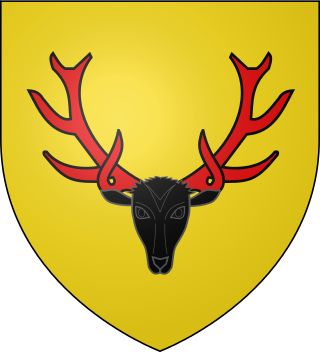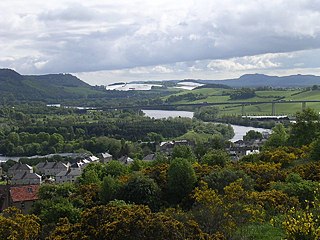
In later Anglo-Saxon England, 10th to 11th centuries, a thegn or thane was an aristocrat who owned substantial land in one or more counties. Thanes ranked at the third level in lay society, below the king and ealdormen. Thanage refers to the tenure by which lands were held by a thane as well as the rank.
In early medieval Scotland, a mormaer was the Gaelic name for a regional or provincial ruler, theoretically second only to the King of Scots, and the senior of a Toísech (chieftain). Mormaers were equivalent to English earls or Continental counts, and the term is often translated into English as 'earl'.

Seax-Wica, or sometimes Seax Witchcraft, is a tradition of neopagan practice blending aspects of Wicca with the iconography of Anglo-Saxon paganism, while not seeking to reconstruct the early mediaeval religion itself.
The Battle of Wippedesfleot took place in 465 between the Anglo-Saxons, led by Hengest, and the Britons. It is described in the Anglo-Saxon Chronicle thus:
Crínán of Dunkeld, also called Crinan the Thane, was the hereditary abbot of the monastery of Dunkeld, and perhaps the Mormaer of Atholl. Crínán was progenitor of the House of Dunkeld, the dynasty which would rule the Kingdom of Scotland until the later 13th century. He was the son-in-law of one king, and the father of another.

Clan Brodie is a Scottish clan whose origins are uncertain. The first known Brodie chiefs were the Thanes of Brodie and Dyke in Morayshire. The Brodies were present in several clan conflicts, and during the civil war were ardent covenanters. They resisted involvement in the Jacobite uprisings, and the chief's family later prospered under the British Empire in colonial India.
Scottish Society in the High Middle Ages pertains to Scottish society roughly between 900 and 1286, a period roughly corresponding to the general historical era known as the High Middle Ages.

Garioch is one of six committee areas in Aberdeenshire, Scotland. It has a population of 46,254, which gives it the largest population of Aberdeenshire's six committee areas. The Garioch consists primarily of the district drained by the River Ury and its tributaries the Shevock and the Gadie Burn.

Formartine is a committee area in Aberdeenshire, Scotland. This district extends north from the River Don to the River Ythan. It has a population of 36,478.

Clan Calder is a Highland Scottish clan. The clan is recognised by the Lord Lyon King of Arms but as it does not currently have a clan chief it is therefore considered an armigerous clan.
The British nobility is made up of the peerage and the (landed) gentry. The nobility of its four constituent home nations has played a major role in shaping the history of the country, although the hereditary peerage now retain only the rights to stand for election to the House of Lords, dining rights there, position in the formal order of precedence, the right to certain titles, and the right to an audience with the monarch. More than a third of British land is in the hands of aristocrats and traditional landed gentry.

The Gunderup Runestone, or DR 143, is located in Gunderup, North Jutland County, Jutland, Denmark. It is notable because it is one of few runestones raised in commemoration of a woman.

Gowrie is a region in central Scotland and one of the original provinces of the Kingdom of Alba. It covered the eastern part of what became Perthshire. It was located to the immediate east of Atholl, and originally included the area around Perth, though that was later detached as Perthia.
Sir John Lyon of Glamis was a Scottish nobleman who was Chamberlain of Scotland between 1377 and 1382. He is regarded as the progenitor of the Chiefs of Clan Lyon.
Thane is a city in Maharashtra, India.

Clan Bissett is a Scottish clan. The clan is recognised by the Lord Lyon King of Arms but does not have a clan chief recognised by the Lord Lyon King of Arms, therefore the clan has no standing under Scots Law. Clan Bissett is considered an armigerous clan, meaning that it is considered to have had at one time a chief who possessed the chiefly arms; however, no one at present is in possession of such arms. The surname Bissett is also considered a sept of the Clan Fraser of Lovat.
Thane was the title given to a local royal official in medieval eastern Scotland, equivalent in rank to the son of an earl, who was at the head of an administrative and socio-economic unit known as a thanedom or thanage.
Kausa is a village of Thane District in the state of Maharashtra in India. It is administered by the Thane Municipal Corporation.

Thane of Calder was a title of nobility in the Kingdom of Scotland.
Glenquithle is a steep valley, locality, former feudal barony and thanage, 965 metres south west of Pennan in Aberdeenshire, Scotland.








